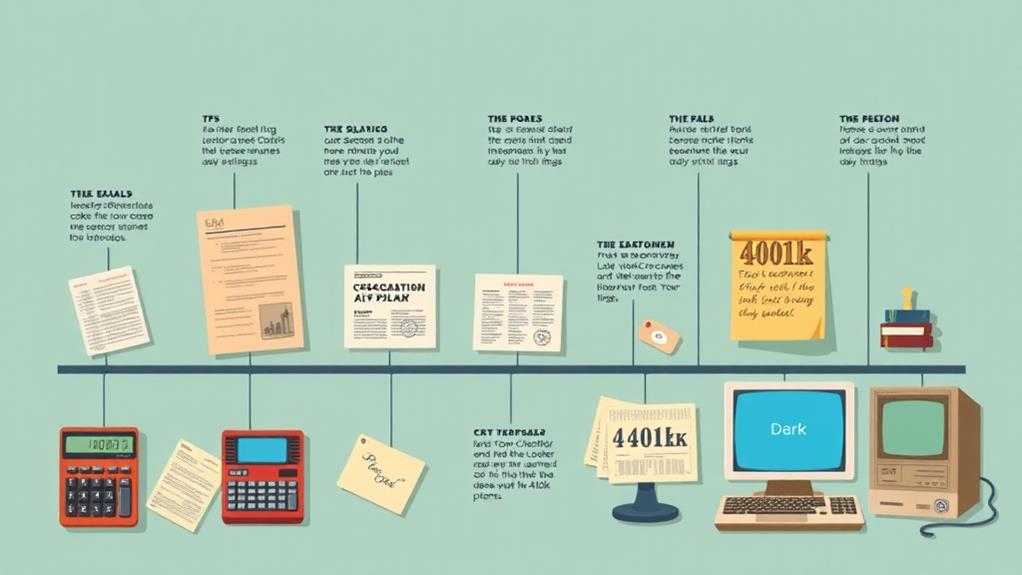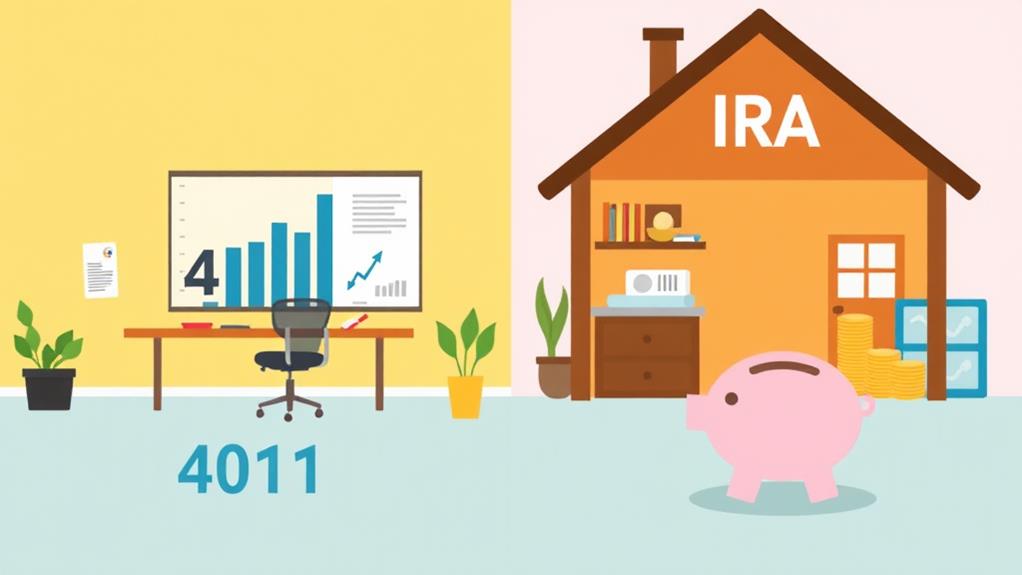A 401(k) is an employer-sponsored retirement savings plan that allows employees to contribute a portion of their salary either pre-tax with a traditional 401(k) or post-tax with a Roth 401(k). This plan offers significant tax advantages, with immediate tax benefits for traditional 401(k) contributions and tax-free withdrawals for Roth 401(k) accounts. Established under the Revenue Act of 1978, the 401(k) has become a cornerstone of retirement planning, boasting over 70 million active participants and $7.4 trillion in assets. Learning about contribution limits, employer matching, and account management strategies can enhance your retirement savings strategy.
Key Takeaways
- A 401(k) is an employer-sponsored retirement savings plan.
- It offers traditional (pre-tax) and Roth (after-tax) contribution options.
- Contributions grow tax-deferred in traditional 401(k)s and tax-free in Roth 401(k)s.
- The 2024 contribution limit is $20,500, with an additional $6,500 catch-up for those 50+.
- Employers often match a percentage of employee contributions.
Definition and Types

A 401(k) is an employer-sponsored retirement plan that enables employees to save for their future through either pre-tax or after-tax contributions. This plan is a pivotal tool in retirement planning, offering significant flexibility and control over retirement savings. There are two primary types of 401(k) plans: traditional 401(k) and Roth 401(k).
In a traditional 401(k) plan, contributions are made with pre-tax dollars. This means that the funds are deducted from the employee’s paycheck before taxes are applied, reducing their taxable income for the year. The contributions grow tax-deferred until withdrawal during retirement.
Conversely, a Roth 401(k) plan involves after-tax contributions. Here, contributions are made from the employee’s paycheck after taxes have been applied. Although this does not reduce the employee’s taxable income in the contribution year, the advantage lies in the tax-free growth and withdrawals during retirement.
Both types of 401(k) plans are designed to provide employees with a systematic and convenient way to build their retirement nest egg. With over 70 million active participants and $7.4 trillion in assets, 401(k) plans have proven to be a cornerstone of retirement planning for many.
Tax Advantages
Tax advantages are a compelling feature of 401(k) plans, offering significant benefits to employees as they save for retirement. Contributions to a traditional 401(k) are made with pre-tax dollars, effectively reducing one’s taxable income in the year of contribution. This immediate tax advantage can be substantial, particularly for those in higher tax brackets. Additionally, the growth of funds within a traditional 401(k) is tax-deferred, meaning taxes are only paid upon withdrawal during retirement, when individuals may be in a lower tax bracket.
On the other hand, Roth 401(k) contributions are made with after-tax dollars, which means there is no immediate tax benefit. However, the long-term tax advantage becomes evident during retirement. Withdrawals from a Roth 401(k) are tax-free, provided certain conditions are met, offering significant relief from taxes at a time when income may be more limited. This tax-free growth can be particularly advantageous for those expecting to be in a higher tax bracket in retirement.
Both traditional and Roth 401(k) plans provide distinct tax advantages, enabling individuals to choose a strategy that best aligns with their retirement savings goals and anticipated future tax situation. This flexibility enhances the effectiveness of 401(k) plans as powerful retirement savings tools.
History of 401(k) Plans

The history of 401(k) plans is a fascinating journey that began with the Revenue Act of 1978, which introduced provisions for tax-advantaged retirement savings. Before the advent of 401(k) plans, retirement savings relied mainly on employer-funded pension schemes. The Act laid the groundwork for a shift towards defined contribution plans, providing employees with greater control over their retirement savings through pretax contributions.
Ted Benna is credited with pioneering the modern 401(k) plan design, allowing employees to contribute a portion of their salaries to their retirement funds. This innovative approach offered an alternative to the traditional employer-funded pension plans and revolutionized retirement savings. The flexibility and tax advantages of 401(k) plans led to their widespread adoption and growth.
Today, various types of 401(k) plans exist, each offering unique benefits. Here are three key milestones in the evolution of 401(k) plans:
- Revenue Act of 1978: Established the legal framework for 401(k) plans.
- Early 1980s: Employers began widely adopting 401(k) plans due to their flexibility and cost-effectiveness.
- 1990s onwards: Expansion and diversification of plan types, including Roth 401(k)s and other variations.
This progression underscores the importance of 401(k) plans in modern retirement planning.
Contribution Limits
Understanding the contribution limits of 401(k) plans is crucial for effective retirement planning. In 2024, the annual contribution limits for 401(k) plans are set at $20,500 for individuals under 50 years old. This cap guarantees that contributions remain within a manageable threshold, encouraging disciplined savings without overextending financial resources.
For individuals aged 50 and above, the opportunity to make catch-up contributions allows an additional $6,500 to be contributed beyond the standard limit, bringing their total to $27,000. This provision aids in bolstering retirement savings as retirement age approaches.
Furthermore, the total contribution limit for a 401(k) account, which includes both employee contributions and employer matches, stands at $61,000 for 2024. Financial advisors frequently recommend setting aside 10-15% of one’s income into 401(k) plans to build a robust retirement savings. This advice aligns with the average contribution rate, which was 14.2% in the first quarter of 2024, reflecting a prudent approach to securing financial stability in later years.
Employer Matching

Employer matching is a vital aspect of many 401(k) plans, where employers contribute a specified percentage of an employee’s salary to their retirement account. This benefit is priceless for enhancing retirement savings. By leveraging employer contributions, employees can greatly strengthen their retirement nest egg.
To fully capitalize on this, consider the following:
- Understand Matching Percentages: Employers typically match a percentage of your salary, often between 3% and 6%. Knowing these percentages helps in strategizing your own contributions to maximize employer matching.
- Meet the Contribution Threshold: To receive the full employer match, you must contribute a certain amount or percentage of your salary. Make sure you are meeting or exceeding this threshold to optimize your retirement savings.
- Monitor the Vesting Schedule: Employer contributions might be subject to a vesting schedule. This means you may need to remain employed for a defined period before the employer’s contributions become fully yours.
Maximizing contributions within the 401(k) plan, particularly to meet the employer matching criteria, is an essential strategy. By doing so, you can greatly enhance your retirement nest egg, securing a more stable financial future.
Vesting and Catch-Up Contributions
Building on the significance of employer matching, another vital aspect of managing a 401(k) effectively involves understanding vesting schedules and leveraging catch-up contributions.
Vesting refers to the ownership of employer-contributed funds within a 401(k) account. Different vesting schedules dictate when these funds become fully owned by the employee. Some plans offer immediate vesting, where employer contributions are owned right away. Others use graded vesting, gradually increasing ownership over time, or cliff vesting, where full ownership is granted after a specific period.
Understanding these schedules is essential for maximizing retirement savings and ensuring complete ownership of employer contributions.
For those nearing retirement, catch-up contributions provide an additional opportunity to boost savings. Individuals aged 50 and older are allowed to contribute beyond the standard annual limits set by the IRS. For 2024, this catch-up contribution limit is $6,500, on top of the regular contribution limit.
Managing Your Account
When managing your 401(k) account, it is essential to understand the options available when changing jobs, such as transferring your account to a new employer’s plan or rolling it over into an IRA.
Regularly monitoring your account and exploring various investment options can help align your portfolio with long-term growth strategies and retirement goals.
Additionally, seeking guidance from financial advisors can provide valuable insights to maximize the effectiveness of your retirement savings.
Changing Jobs Options
Managing a job change involves several significant decisions, including how to handle your 401(k) account. Ensuring effective management of your retirement savings during a job change is vital. Here are three primary options to keep in mind:
- Transfer to New Employer’s Plan: Opting to move your 401(k) to your new employer’s plan can help you keep any employer match benefits. This choice often streamlines your retirement management by combining accounts, although it’s crucial to assess the new plan’s investment choices and fees.
- Rollover into an IRA: Rolling over your 401(k) into an IRA provides more control over your investment choices and typically wider options than employer-sponsored plans. This approach can also help avoid penalties and maintain tax-deferred status. Make sure to grasp the associated fees and management requirements.
- Leave It with Former Employer: You could retain your 401(k) with your previous employer. While this delays immediate decisions, it might restrict your oversight and flexibility in investment choices. Also, take into account potential fees and the performance of the former employer’s plan.
Thoroughly assessing these transfer options will help you maintain control and optimize the growth potential of your retirement savings during a job change.
Account Transfer Process
Moving your 401(k) account during a job change requires careful planning and attention to detail. When changing jobs, you have the option to transfer your 401(k) account to your new employer’s plan or to an Individual Retirement Account (IRA). The transfer process involves completing the necessary paperwork to facilitate the movement of funds from one account to another, ensuring your retirement savings remain intact.
Direct rollovers are generally recommended to avoid taxes and penalties. This method transfers the funds directly from your old 401(k) account to the new plan or IRA, maintaining tax-deferred status and promoting continued investment growth. Timing is pivotal in this process, as there is often a limited window after leaving a job to make these decisions.
Failure to act within this period could result in unintended tax consequences or potential penalties.
Engaging in a well-planned transfer process can help you preserve and potentially enhance your retirement savings. Whether moving the funds into a new employer’s plan or an IRA, ensuring that all paperwork is correctly completed will facilitate a smooth changeover, helping you maintain control over your investment growth and financial future.
Long-term Growth Strategies
Maximizing the long-term growth potential of your 401(k) account requires a strategic and disciplined approach. Employing a diversified approach to your investment options is crucial for balancing risk and reward. To effectively manage your account, consider these key strategies:
- Regularly Review and Adjust Investments: Align your portfolio with your risk tolerance and retirement goals. Periodic performance monitoring guarantees your investments remain on track.
- Consider Fees and Expenses: High fees and expenses can diminish your account’s growth. Seek out cost-efficient investment options to optimize your returns.
- Periodic Portfolio Rebalancing: Maintain an appropriate asset allocation by periodically rebalancing your portfolio. This helps manage risk and aligns your investments with your long-term growth strategies.
Withdrawal Rules
Understanding the withdrawal rules for a 401(k) is crucial to guarantee compliance and avoid unnecessary penalties. Typically, withdrawals from a 401(k) before age 59½ incur a 10% penalty in addition to income taxes. However, there are specific exceptions for penalty-free withdrawals, such as in cases of disability, substantial medical expenses, and certain first-time home purchases.
Required Minimum Distributions (RMDs) are another essential aspect, mandating that withdrawals must begin by age 72 to prevent penalties.
Roth 401(k) accounts, however, offer more flexibility as they do not impose RMD requirements during the account holder’s lifetime, allowing for more strategic financial planning.
Additionally, job changes provide opportunities to control your retirement funds effectively. You can roll over your 401(k) funds into a new employer’s plan or an Individual Retirement Account (IRA) to avoid penalties and maintain tax-deferred growth. Ensuring that these rollovers are executed correctly is important to avoid unintended tax consequences.
401(K) Vs. IRA

When comparing a 401(k) to an IRA, key differences emerge in contribution limits, tax treatment, and investment flexibility.
The IRS sets annual contribution limits for both, but 401(k) plans often allow for higher contributions.
Additionally, while both types of accounts offer tax advantages, the specific tax treatments and available investment options can vary greatly between them.
Contribution Limits Comparison
Exploring the landscape of retirement savings requires a clear understanding of contribution limits for different plans, particularly 401(k)s and IRAs. In 2024, the contribution limits for these accounts highlight significant differences.
For an individual, the 401(k) contribution limit is set at $20,500, whereas an IRA allows contributions up to $6,000.
To maximize retirement savings, financial advisors often suggest contributing 10-15% of your income to a 401(k). This recommendation aligns with the average contribution rate observed in Q1 2024, which was 14.2%, reflecting a positive savings trend. Here are three key points to keep in mind regarding contribution limits:
- Catch-up Contributions: For those aged 50 and older, 401(k)s permit an additional $6,500, while IRAs allow an extra $1,000.
- Employer Matches: Including employer matches, the total 401(k) contribution limit can reach $61,000, vastly exceeding the IRA’s $7,000 cap.
- Comparison for Individuals: While IRAs offer flexibility, the higher limits and potential employer matches of 401(k)s make them a formidable tool for retirement planning.
Understanding these contribution limits enables individuals to make informed decisions, optimizing their retirement savings strategy with the guidance of a financial advisor.
Tax Treatment Differences
Tax treatment differences between a 401(k) and an IRA play a pivotal role in shaping retirement savings strategies. The primary distinction lies in how contributions and withdrawals are taxed.
A 401(k) allows for pre-tax contributions, which effectively reduce your taxable income in the year they are made. Conversely, an IRA offers tax-deductible contributions up to a certain limit, providing similar tax advantages.
When it comes to withdrawals in retirement, both 401(k) and Traditional IRA accounts treat them as ordinary income, subjecting them to income tax. This deferred tax treatment can be beneficial if you expect to be in a lower tax bracket during retirement.
However, Roth options present a different scenario. Roth 401(k) contributions are made with after-tax dollars, ensuring tax-free withdrawals in retirement, akin to the Roth IRA’s tax treatment.
Both 401(k) and IRA accounts are governed by annual contribution limits set by the IRS, ensuring these tax advantages are regulated. By understanding these tax treatment differences, individuals can make more informed decisions regarding their retirement savings, tailoring their approach to optimize tax benefits and achieve greater financial control in their later years.
Investment Flexibility Options
Investment flexibility is an important factor to keep in mind when comparing a 401(k) to an IRA. While both retirement accounts have their merits, the degree of investment flexibility they offer can greatly impact your retirement strategy.
A 401(k) typically provides limited investment options as it is an employer-sponsored plan managed by the employer’s chosen investment firm. This setup often restricts the range of available funds, limiting your control over investment decisions.
In contrast, an IRA allows for greater flexibility in choosing individual stocks, bonds, and a wider array of funds tailored to individual preferences.
Consider these key points:
- Investment Options: IRAs generally offer a broader selection of asset classes, enhancing diversification opportunities.
- Control: With an IRA, individuals have more control over their investment decisions, allowing for strategies that align closely with personal financial goals.
- Employer-Sponsored Plans: 401(k) plans are managed by employers, often resulting in fewer choices and less control over specific investments.
For those who prioritize customization and control over their retirement investments, an IRA may offer more appealing benefits. Understanding these differences can help you make informed decisions that align with your long-term financial objectives.
Additional Retirement Options
The landscape of retirement planning is replete with various strategies and account types, each designed to cater to specific financial goals and situations. A Roth 401(k) and a traditional 401(k) are fundamental components of retirement savings. While both accounts allow for significant retirement funds accumulation, they differ in tax treatment and withdrawal rules.
Roth 401(k) contributions are made post-tax, allowing tax-free withdrawals in retirement, whereas traditional 401(k) contributions are pre-tax, with taxes due upon withdrawal.
Contribution limits for these accounts are set annually by the IRS, making it vital to stay informed to maximize potential benefits. Beyond these traditional accounts, IRA rollovers play an important role when shifting between jobs or consolidating accounts. Moving retirement funds to a new financial institution can be streamlined through conduit IRAs, ensuring continuity in retirement planning.
For those seeking to amplify their retirement savings, the mega backdoor Roth 401(k) conversion offers an advanced strategy. This method enables higher contributions beyond standard limits by converting after-tax contributions into a Roth 401(k). Understanding these diverse options empowers individuals to tailor their retirement plans effectively and achieve financial security.
Frequently Asked Questions
What Is a 401K and How Does It Work?
A 401(k) is an employer-sponsored retirement plan allowing employees to save pre-tax income, potentially matched by employers, into various investments. Withdrawals before age 59½ usually incur penalties, promoting long-term retirement savings.
What Happens to My 401K if I Quit?
Upon quitting a job, you can leave your 401(k) with the former employer, roll it over to a new employer’s plan, or transfer it to an IRA. Each option offers different levels of control and investment flexibility.
Do You Lose Your 401K if You Get Fired?
If you get fired, you do not automatically lose your 401(k) account. Options include leaving the funds in the current plan, rolling them over to a new employer’s plan, or transferring to an IRA, depending on balance thresholds and fees.
Are 401K Good or Bad?
401(k) plans are generally advantageous due to tax benefits and employer matching contributions, which enhance retirement savings. Despite potential drawbacks such as limited investment options and fees, their benefits typically outweigh disadvantages for long-term financial planning.
Conclusion
A 401(k) is an essential retirement savings tool offering significant tax advantages and potential employer matching contributions. Understanding its various types, contribution limits, and withdrawal rules is crucial for effective financial planning. Comparing a 401(k) to other retirement options, such as IRAs, can help determine the best strategy for individual retirement goals. Proper management of a 401(k) account and awareness of its historical context further enhance its utility in securing a stable financial future.

